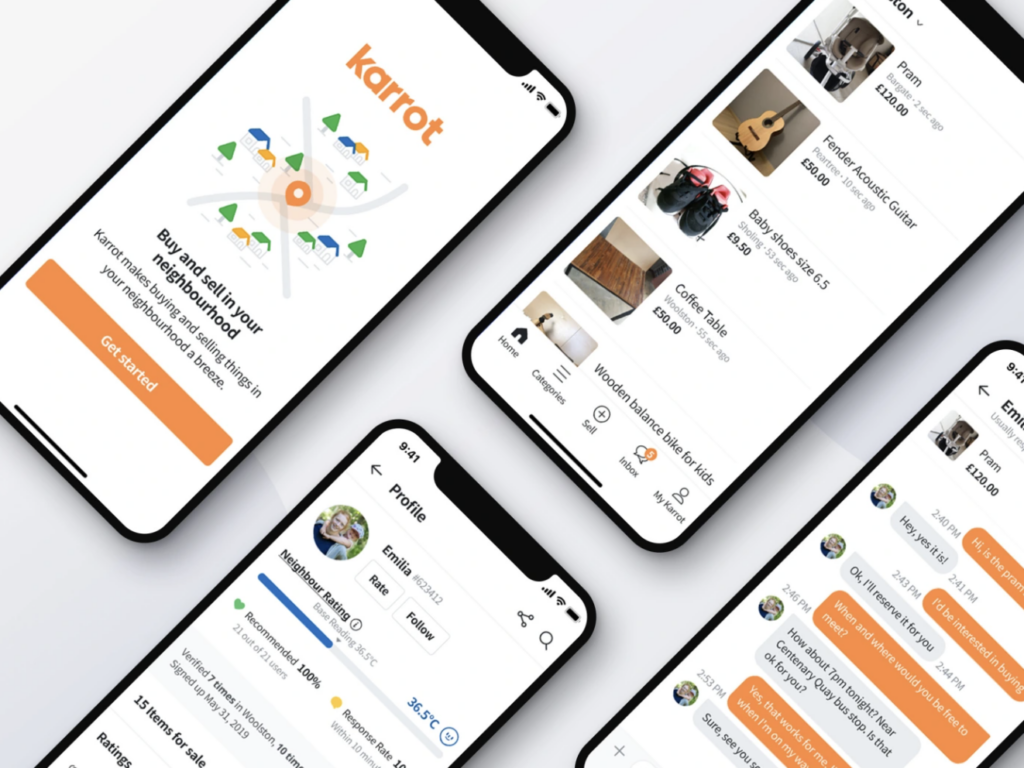A Closer Look at South Korea’s Beloved “Neighborhood Market” Platform

What exactly makes Karrot work and does it make sense to go global?
Karrot (Translation: “Your Vicinity”)
Karrot is a hyperlocal e-commerce app in South Korea. It is a “neighborhood market” for secondhand goods that connects buyers and sellers within a six-kilometer radius, inspired by the idea that people are much more likely to trust transactions with others from their own community. The app is incredibly easy to use – sellers can post their items in less than 30 seconds and buyers can use a powerful search function to browse and select from a wide range of items. When a buyer finds an item that they’d like to buy, they simply initiate a private chat with the seller to meet and complete the transaction. Because Karrot is a hyperlocal app, the buyer and seller typically meet at a local spot in their shared community, which not only eliminates the need for shipping but also creates a sense of safety given the familiarity of the location.

Driving User Engagement
As of August 2022, Karrot had 30 million cumulative users and 18 million monthly active users, with some users even saying they are “addicted” to the app. Interestingly, users liken Karrot to an entertaining social media app rather than a transactional e-commerce platform, viewing item posts as social media “uploads” that update them on the “status” of their neighborhood market. In addition, Karrot features hyperlocalized advertising that has been a key driver of user acquisition for the app; this also happens to be its only form of revenue.
To further increase user engagement, Karrot recently began partnering with offline-to-online (“O2O”) start-ups that offer day-to-day services. Currently, there are thousands of Korean O2O apps that allow users to purchase services such as cleaning and laundry; however, given the heavily fragmented market, there is fierce competition for new user acquisition. By partnering with these O2O start-ups to offer their services through its platform, Karrot creates value by (a) boosting visibility, user traffic, and thereby the number of transactions for the O2O start-ups and (b) significantly expanding the range of offerings for Karrot users, which not only creates a one-stop shop that improves the app experience for users but also improves user acquisition and retention rates for Karrot.
As its user base rapidly expands, Karrot must continue to be vigilant about key concerns such as user reliability and safety. Currently, it mitigates these risks through its identity as a “neighborhood market,” given Korea’s tightly-knit communities and the culture’s obsession with upholding a good reputation within the community for the sake of one’s family. As such, it is more likely than not that people will reliably honor a proposed transaction and that the exchange will be handled in a courteous manner. This unique control mechanism is further enforced by Karrot’s decision to keep professional sellers out of its platform to maintain the local, community-like feel of the app. In addition, Karrot actively addresses user reliability and safety risks by (a) using a location and mobile verification for all users and (b) associating a Karrot Rating with all user profiles, strictly based on other users’ reviews and feedback.

Going Global?
I am rather skeptical about Karrot’s scalability. Karrot is currently available in four countries outside of South Korea (the U.K., the U.S., Canada, and Japan) and is focused on expanding its global presence. However, I personally believe that the “neighborhood market” concept was a good fit specifically for the South Korean market. In addition to the cultural implications discussed above, Korean living spaces tend to be smaller and heavily clustered, which consolidates a high number of users per neighborhood and, thus, a wide variety of goods. In the U.S. market, for example, where people tend to live in less geographically clustered spaces and tend to lead more private lives, will a “neighborhood market” be as engaging, fun, and trustworthy?
My greatest concern with regard to Karrot’s sustainability is that the platform only makes money through advertisements. The absence of any fees and commissions associated with platform usage has been critical to growing Karrot’s cumulative user and transaction volume; however, this means that Karrot cannot capture value that is proportionate to its own growth. As a marketplace, Karrot’s value creation offering hinges on a critical mass of quality users. Therefore, Karrot cannot afford to alienate its user base by starting to charge them. Charging also creates a huge risk of disintermediation given that Karrot currently facilitates its transactions through a match-and-chat system.
Nevertheless, I am curious as to how Karrot plans to tackle these challenges going forward and will actively be following their global expansion story.



This is a cool app! When reading it made me think a lot of Craigslist or Facebook Marketplace. I wonder like you how scalable/global the Karrot could be in other countries if other apps/platforms exist already in some capacity. Maybe the more formalized nature of their app would be a selling point? Anyways, thank you for posting, this was a cool read!
Thanks for sharing, I’ve never heard of this and looks really interesting! I like the concept of being hyperlocal neighborhood market, and also got the vibe of Facebook Marketplace; however, it seems like this app and community carries a stronger reputation and implicit trust. I share your concerns with it’s chances of success in the US given the less densely populated and city layouts, though I wonder if they may get some traction in specific immigrant neighborhoods that may be more tight-knit. Do you have a sense of where they are operating in the US?